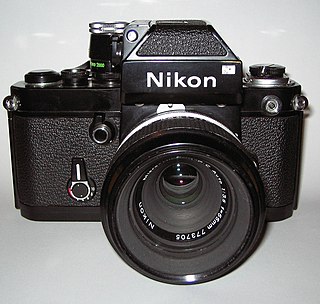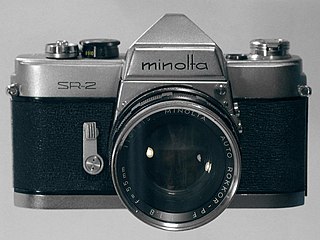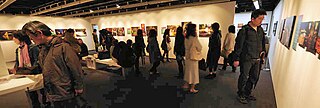Kogaku may refer to:
- Kogaku, a Neo-Confucian school of thought in Japan, see kokugaku
- Kogaku, journal of the Optical Society of Japan
Kogaku may refer to:

Higashiōsaka is a city located in Osaka Prefecture, Japan. As of 31 January 2022, the city had an estimated population of 489,077 in 233124 households and a population density of 7900 persons per km². The total area of the city is 61.78 square kilometres (23.85 sq mi). The city is known as one of the industrial cities of Japan and "the rugby football town".
CKS or C.K.S. may refer to:

Pentax is a brand name used primarily by the Japanese multinational imaging and electronics company Ricoh for DSLR cameras, lenses, sport optics, and CCTV optics. The Pentax brand is also used by Hoya Corporation for medical products & services, TI Asahi for surveying instruments, and Seiko Optical Products for certain optical lenses.

The Nikon FM is a mechanically operated, interchangeable lens, 35 mm film, single-lens reflex (SLR) camera. It was manufactured in Japan between 1977 and 1982 by Nippon Kogaku K. K..
Kokugaku was an academic movement, a school of Japanese philology and philosophy originating during the Tokugawa period. Kokugaku scholars worked to refocus Japanese scholarship away from the then-dominant study of Chinese, Confucian, and Buddhist texts in favor of research into the early Japanese classics.

The Nikon FA was an advanced amateur-level, interchangeable lens, 35 mm film, single-lens reflex (SLR) camera. It was manufactured by the Japanese optics company Nippon Kogaku K. K. in Japan from 1983 to 1987. The FA used a titanium-bladed, vertical-travel Nikon-designed, Copal-made focal plane shutter with a speed range of 1 to 1/4000th second plus Bulb and flash X-sync of 1/250th second. It was available in two colors: black with chrome trim and all black. The introductory US list price for the chrome body only was $646. Note that SLRs usually sold for 30 to 40 percent below list price.

The Nikon FE is an advanced semi-professional level, interchangeable lens, 35 mm film, single-lens reflex (SLR) camera. It was manufactured by Nikon in Japan from 1978 to 1983, and was available new from dealer stock until c. 1984. The FE uses a metal-bladed, vertical-travel focal plane shutter with a speed range of 8 to 1/1000 second, plus Bulb, and flash X-sync of 1/125th second. It had dimensions of 89.5 millimetres (3.52 in) height, 142 mm (5.6 in) width, 57.5 mm (2.26 in) depth and 590 grams (21 oz) weight. It was available in two colors: black with chrome trim and all black. As on the FM, its model designation did not appear on the front of the camera, but was engraved as a small "FE" preceding the serial number on the rear of the housing.

The Nikon F2 is a professional-level, interchangeable lens, 35 mm film, single-lens reflex (SLR) camera. It was manufactured by the Japanese optics company Nippon Kogaku K. K. in Japan from September 1971 to 1980. It used a horizontal-travel focal plane shutter with titanium shutter curtains and a speed range of 1 to 1/2000 second plus Bulb and Time, and flash X-sync of 1/80 second. It had dimensions of 98 mm height, 152.5 mm width, 65 mm depth and 730 g weight. It was available in two colors: black with chrome trim and all black.

Nikkormat was a brand of cameras produced by the Japanese optics company Nippon Kogaku K. K., as a consumer version of the professional Nikon brand. Nikkormat cameras, produced from 1965 until 1978, were simpler and more affordable than Nikon-branded cameras, but accepted the same lenses as the Nikon F series cameras.

Topcon Corporation is a Japanese manufacturer of optical equipment for ophthalmology and surveying.
The Optical Society of Japan (OSJ) is professional organization of physicists conducting research in Optics. The organization was founded in 1952 as a division of the Japan Society of Applied Physics (JSAP). It has nearly 2,000 members and is the biggest division of JSAP.

Kōgaku-ji (向嶽寺), originally Kōgaku-an, is a Buddhist temple belonging to the Rinzai school of Japanese Zen. located in the city of Kōshū, Yamanashi, Japan. It is the head temple of one of fourteen autonomous branches of the Rinzai school. Its main image is a statue of Shaka Nyōrai. The temple, including its famed Japanese garden is not open to the general public.

The Minolta-35 was launched in the spring of 1947 by Chiyoda Kogaku. It was the first successful new 35mm rangefinder camera with Leica specifications to emerge on the market after World War II that uses the 39mm screw lens-mount. The Minolta-35 range of cameras was manufactured in quantities during its twelve-year production period, totalling about 40,000 units. Only the 1933 FED and the 1940 Leotax cameras had appeared successfully before it, although several Leica copies had appeared in both Italy and Japan.

The Minolta SR-2 was presented in 1958 as the first 35mm SLR camera from Chiyoda Kogaku. Popular cameras of this type at that time were mainly from Europe but a few from Japan, including the Asahi Pentax, the Miranda T and the Topcon R. The miniature SLR camera concept was conceived in the 1930s at Ihagee in Dresden, resulting in the 1936 Kine Exakta. Influential cameras designs like that of the 1939 KW Praktiflex, the 1949 ZI Contax S, and 1952 the KW Praktina marked the steady progress toward a perfected SLR. Several features of the latter seem to have influenced the design of the SR-2 although dissimilar in many respects. The obvious similarities are the stepped top plate, the carrying strap lugs, the self-timer lever and some general body features.
Swans is the brandname of the Japanese eyewear manufacturer Yamamoto Kogaku Co., Ltd. located in Osaka, Japan.

Nikon Salon is the name given to exhibition spaces and activities run by Nikon in Japan.

The Nikon was the first camera introduced by the optical manufacturer Nippon Kogaku KK. It is a 35mm rangefinder camera, in retrospect known as the Nikon I. The original design was approved by September 1946, and the camera was released in March 1948. At first, it was sold locally, and it did not come to the attention of the western media until 1950, when photographers from the magazine Life were shown photographs taken with these cameras. The lenses draw special attention, like the Nikkor-P.C 1:2 f=8.5cm. A demand to fit Nikkors to the reporters' Leicas were immediately met at the factory in Tokyo, and soon the word spread about these Japanese lenses which were just as good as, or possibly better than their German counterparts. The camera design was strongly inspired by the German Contax and Leica cameras. After careful studies of these, Nippon Kogaku had decided to base their camera on the Contax, but substitute the complicated shutter design for the cloth focal plane shutter of the Leica, these being considered the best features from either camera.
The National Institute of Technology, Okinawa College is a college of technology in Nago, Japan. Its abbreviated name is NIT-Ok.
Minolta mount may refer to:
Ricoh Synchrofax is a Japanese dictating machine from 1959, reissued in 1974 as the 3M Sound Page as official teaching material in the US-state of Oklahoma. It is also known as sound paper. Inventor Sakae Fujimoto filed the patents US3074724A and US3046357A in 1959.